Reconstructing the Fire History of the Jarrah Forest of south-western Australia
David Ward and Gerard Van Didden. 1997. Reconstructing the Fire History of the Jarrah Forest of south-western Australia. A Report to Environment Australia under the Regional Forest Agreement December 1997.
David Ward is Senior Research Scientist, Department of Conservation and Land Management (CALM) in Western Australia and Visiting Senior Research Fellow, Curtin University, Perth
Gerard Van Didden is a Retired Department of Conservation and Land Management officer
Full text [here]
Selected excerpts:
Introduction
… The jarrah forest is a complicated system, involving humans for thousands of years. Anthropologists tell us of the importance of fire in Aboriginal culture, and there is historical evidence in the letters and journals of early European explorers of south-western Australia that fires occurred as frequently as every 2-4 years, at least in some parts. …
This study reconstructs fire history from marks on the stems of grasstrees (Xanthorrhoea spp). This information meshes with the broad perspectives of history and anthropology, giving a framework within which we can link the concerns of biologists, soil scientists, fire fighters, and managers. In turn, the framework can be used to create a map of consciously linked research questions, relevant to management of the jarrah forest. …
Methods
Grasstree (Xanthorrhoea spp) stems were cleaned with a grinder, so exposing cream and brown growth rings (Ward 1996), which match with internal growth bumps (Lamont and Downes 1979). The grinding also exposed some bands of dark pigment in the old leaf bases. These dark bands occurred consistently at points on the stems where fires were known from CALM records to have occurred; and where fires were likely to have occurred, since the grasstree had flowered at that point. …
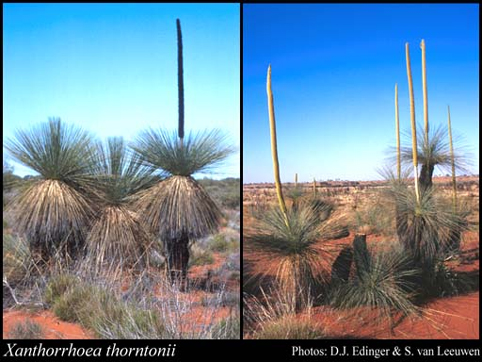
Xanthorrhoea thorntonii. Photo courtesy Department of Conservation and Land Management [here]
Some leafbases were carefully removed, washed in alcohol, and cut into 1 centimetre pieces measured from the proximal end. The length of leafbase can vary from tree to tree due to burning away by past fires (Drummond 1847). In this case each leafbase gave 5 pieces. Each year showed the twin band of cream and brown leafbases shown in Figure 1, and these were separated, giving a hundred samples for the decade. These samples were analysed by pyrolysis gas chromatography and mass spectrometry to identify the dark pigment (Challinor 1989, 1995). They were also analysed for zinc, calcium, magnesium, manganese and copper. …
Results
Analysis by gas chromatography and mass spectrometry showed that for the samples taken immediately above, on, and immediately below the dark band in Figure 2, the compound lapachol (2-hydroxy-3-(3-methyl-2-butenyl), 1, 4-naphthalenedione) was absent from the leafbase below, present in the dark leafbase, and present as a trace in the leafbase immediately above. …
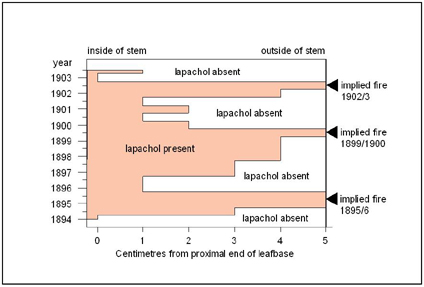
Figure 3: Presence/absence of lapachol in vascular bundles.
Some chemical analysis has been completed on leafbases, but not all the results are yet available. There will be a large amount of data, but early analysis shows changes in the levels of nutrients and trace elements which match with implied fire events. …
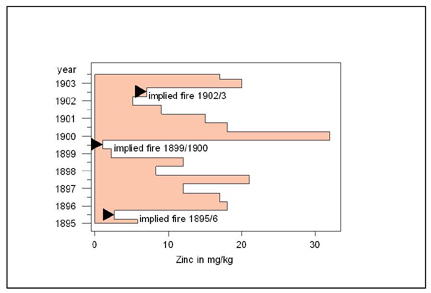
Figure 7: Zinc at 4 cm from proximal end of grasstree leafbase
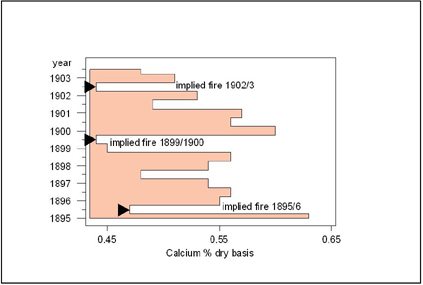
Figure 8: Calcium at 1 cm from proximal end of grasstree leafbase
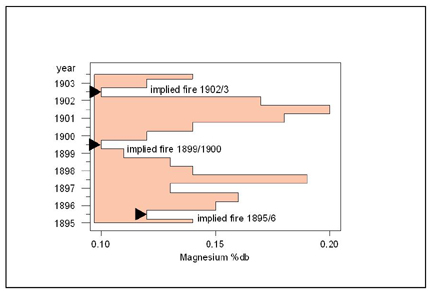
Figure 9: Magnesium at 4 cm from proximal end of grasstree leafbase
A total of 159 grasstrees was examined at 50 sites distributed throughout the jarrah forest. Each tree yielded information on at least two decades, some giving a record of over twenty decades. The final data matrix consisted of 1548 records, each record containing fields for the number of fires in that decade, the annual rainfall at that site, site latitude and longitude, vegetation type, distance from creek, etc. …
The reconstructed fire history of the jarrah forest is summarised in Figure 15. The large standard errors in the earliest decades are caused by the small size of the samples, such old trees being relatively rare. The pronounced drop in fire frequency between 1860 and 1870 coincides with a severe measles epidemic which ravaged the Nyoongar population in the early 1860s (Richards 1978, Cliff et al 1993). On many stems the change in fire frequency is quite abrupt for that period. At some sites the abrupt drop in fire frequency occurs in the 1880s, when a second severe measles epidemic occurred (Hammond 1933, Hasluck 1942). The abrupt drop in fire frequency in the 1940s is probably due to the absence of young men on military service and also due to an official policy of banning burning on the grounds that fires might provide guidance to Japanese night bombers. The decline in fire frequency in recent decades is due to stricter management plans, public opposition to burning, and lack of opportunity and resources to carry it out.
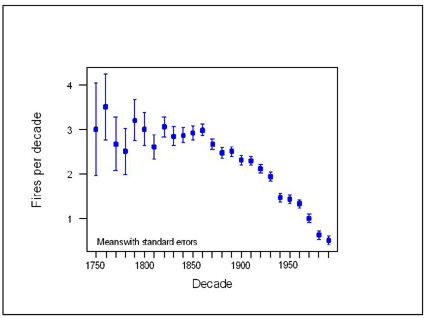
Figure 15: Reconstructed jarrah forest fire history by decade
Discussion
… The central importance of fire in Nyoongar culture is clear not only from present day Nyoongar elders (Mr. Jo Walley, personal communication), but also from early European observers. …
If Nyoongar people were burning the forest on a frequent basis immediately before European settlement, then it is likely that such a fire regime had been in place for many thousands of years. Any plants or animals which could not tolerate it would have either disappeared, or been driven back into refuges in moist or rocky places.
There is historical and anthropological evidence that Nyoongar people tended to light fires close to creeks, swamps, or other water bodies. They travelled mainly along creeks for the obvious reason of access to water, and because these were the most productive areas for food (Hallam 1975). …
This study has given a broad picture of the fire history of the jarrah forest, but there is a need now for more detailed studies at specific sites. More detailed study may yet reveal a relationship between landform, vegetation and past fire regime.
Once achieved, such a classification would give CALM the option of including in its fire management smaller, more precise burns, as a supplement, or alternative, to the broader techniques used at present. …
We should also consider the term “nature conservation”. Is the jarrah forest remnant we have now “natural”, or has it been shaped by forestry practices? Was the pre-European jarrah forest “natural”, or was it the result of millennia of human disturbance by fire? Do we wish to conserve what we have now - or do we wish to restore and conserve the immediate pre-European condition? A third possibility is to try to restore the (presumably natural) pre-Aboriginal state, if we can determine what it was. In the case of fire regime it was possibly one of occasional, extremely fierce fires caused by lightning. Would that be compatible with our present agricultural, residential, and industrial land uses?
